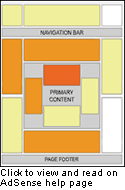Most people will tell you to place Google AdSense ads at heatmap hot spots. Google offers the same advice on its support pages – Where should I place Google ads on my pages? It is alleged that displaying AdSense ads on the areas that receive the highest visitor attention (the hot spots on a web page heatmap) will increase the clickthru rate (CTR). In this article we explore the truth behind this assertion with some “real world” numbers.
Increase AdSense earnings by increasing clickthru rate (CTR)
We all want to increase our AdSense revenue. One way to do this is to increase the clickthru rate. Other factors remaining constant, a two-fold increase in CTR will result in doubling of the earnings, right?
Sponsored Links
Before we delve deeper into whether the Google AdSense CTR increases once you place the ads at the heatmap hot spots, let’s take a moment off and consider whether this technique is indeed legitimate.
In my opinion, there should not be any problem in placing AdSense ads at hotspots as this is endorsed by Google itself. In fact, they provide a generalized web site heatmap. The AdSense support page explains that advertisements placed near content rich sections or the web site navigation will perform well as the visitor’s attention is focused on these areas. They have also suggested that blending AdSense ads on certain designs and layout might increase the CTR.
However, Google always recommends putting the user first when deciding on ad placement. We’ll come to this point a little later.
First let us look at the two strategies together – placing AdSense ads on heatmap hot spots and blending them into the design. Shouldn’t these make your ad CTR go through the roof? This is what we shall find out.
Placing Google AdSense at heatmap hotspots and blending them increased earnings 7 fold
Let me start on a positive note. When I first implemented AdSense on this website, I used the 160×600 format and put it on the right column. The ads were blended. This resulted in a very low CTR. In fact, I read somewhere that ads eliciting few clicks (CTR less than 0.5%) are removed from the program.
 I knew I was doing something terribly wrong and this was evident when I checked out the generalized heatmap on Google AdSense support page. The right vertical column had little or negligible visitor attention. So, even though the ads were blended, the CTR was pathetic.
I knew I was doing something terribly wrong and this was evident when I checked out the generalized heatmap on Google AdSense support page. The right vertical column had little or negligible visitor attention. So, even though the ads were blended, the CTR was pathetic.
I then changed my strategy and put ads with the content quite like what I had seen on many other high content websites. The results were startling. The clickthru rate (CTR) increased by a factor of 7 and the earnings jumped five times.
So the Google AdSense heatmap did help me. It showed me where not to put the ads.
When Google AdSense heatmap did not help at all
Now to another experiment based on the Google heatmap. As mentioned in the Google support, ad units placed near the navigation get high clickthrus because the visitor eyes are focused on that area.
Honestly, I was not happy to do this. I believe that such AdSense ad placements would generate accidental clicks, which, was not something I wanted to do and, also, would lead to poor visitor experience – it would be akin to fooling the visitor into clicking on those ads.
So I put an ad unit at the top of the left navigation; furthermore, the ads were really blended well. I ran the ads for a couple of weeks. The results of the experiment – 0.001% clickthru rate… pathetic! And to couple this, the ads weren’t high paying.
Why did this ad placement fail miserably?
First, the heatmap displayed on Google AdSense support page is a general one – it’s not specific to my web site layout and design. No doubts, most web sites layouts are similar, but, subtle differences in colors, layout and structure might give us different heatmaps. Thus, the information provided by this generalized heatmap might not be correct for my web site.
This means we all need to create a heatmap for our web site. And with many companies offering this service, it’s not difficult to do this. Note: You need to decide whether you want a heatmap of mouse click activity or eye tracking. In fact, it won’t be a bad idea to compare the two.
So I went ahead and created heatmaps for the site. Cool! The findings were even more startling.
The Google AdSense ads were indeed at the hottest spots. So why weren’t the visitors clicking? And for this I turn back to Mr. Nielsen. In Fancy Formatting, Fancy Words… Ignored, he mentions that if important information is displayed in fancy formatting, it will be considered a promotion and ignored by the viewer. But my AdSense ads were blended. They didn’t have any fancy formatting. My conclusion is that even though the ads were devoid of fancy formatting, they were ignored because they were interpreted as promotion – which they were!
A few more pointers: The AdSense program is very smart. Changing ad position might change the kind of ad being displayed and this is especially true if you use section targeting. Obviously, such modification might increase your earnings or otherwise and so you need to test and retest.
The take home message: Heatmaps can complement data from AdSense channels and can yield interesting insights on where to place the ads and in which format. However, they are not the only “magic solution” at your disposal.
Where to place AdSense ads and enhancing user experience
[April 2011] A couple of months back, Google implemented a big change on how it ranks web sites. This update to the search engine algorithm has come to be known as Panda and it has created havoc on the web. A lot of famous and ‘quality’ web sites (including this one) have lost huge amounts of traffic because now their pages are no longer ranking high.
Based on extensive discussions on popular forums such as WebmasterWorld.com, it seems that ad placements have played some kind of role in getting sites demoted or otherwise. It’s still a very gray area so please take this with a pinch of salt. Anyway, there has been a very interesting turn of events.
Over the years, publishers have been placing ads above the fold (ATF) based on the advice found on the support pages. The same idea has also been routinely promoted by AdSense Representatives. This apparently seems to have changed! The AdSense Help page now instructs publishers to give importance to the content and, thus, the user experience. Check out the best practices for laying out your site and your ads. In brief:
- Organize content so that the site is easy to navigate.
- Publishers should have substantial content above the fold and not just ads. The ‘in your face’ placements need to go.
- Ads should look like ads! Don’t misguide users by placing images beside them or mimicing their formatting (no blending).
- Use less ads to avoid cluttering the page.




